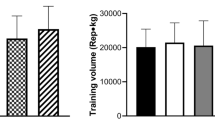Abstract
Purpose
The aim of this study was to investigate whether only 1 multi-joint resistance exercise involving large muscle groups can elicit post-exercise hypotension (PEH).
Methods
A randomized crossover trial was conducted with 13 normotensive-trained women (21.8 ± 2.1 years; 23.5 ± 3.1 kg/m2; blood pressure 100.4 ± 4.9/58.6 ± 5.6 mmHg). They were submitted randomly into two sessions: (a) a single multi-joint resistance exercise session (3 sets of 20 repetitions at 80% of 20 repetitions maximum performed on double-leg press machine) and (b) control session (15 min of resting in a seated position). Blood pressure (BP) was measured before and at 20, 40, and 60 min following the control and resistance exercise sessions.
Results
It was observed a reduction in systolic BP at 40 min (4.8 ± 4.6 mmHg) and 60 min (6.3 ± 4.3 mmHg) post-exercise with a moderate magnitude (d ≥ 0.79, p < 0.05). Moreover, 10 participants (i.e., 77% of the sample) decreased at least 3 mmHg of systolic BP post-exercise. There was no change in diastolic BP and mean BP post-exercise (p > 0.05).
Conclusion
A single multi-joint high-intensity resistance exercise involving large muscle groups and performed within a very low time commitment elicited systolic PEH in normotensive-trained women.




Similar content being viewed by others
References
Chen CY, Bonham AC (2010) Postexercise hypotension: central mechanisms. Exerc Sport Sci Rev 38:122–127. https://doi.org/10.1097/jes.0b013e3181e372b5.Postexercise
Casonatto J, Goessler KF, Cornelissen VA et al (2016) The blood pressure-lowering effect of a single bout of resistance exercise: a systematic review and meta-analysis of randomised controlled trials. Eur J Prev Cardiol 23:1700–1714. https://doi.org/10.1177/2047487316664147
Pescatello LS, Macdonald HV, Lamberti L, Johnson BT (2015) Exercise for hypertension: a prescription update integrating existing recommendations with emerging research. Curr Hypertens Rep 17:87. https://doi.org/10.1007/s11906-015-0600-y
Polito MD, Farinatti PTV (2009) The effects of muscle mass and number of sets during resistance exercise on postexercise hypotension. J Strength Cond Res 23:2351–2357. https://doi.org/10.1519/JSC.0b013e3181bb71aa
Polito MD, da Nóbrega ACL, Farinatti P (2011) Blood pressure and forearm blood flow after multiple sets of a resistive exercise for the lower limbs. Blood Press Monit 16:180–185. https://doi.org/10.1097/MBP.0b013e328348cac4
Trost SG, Owen N, Bauman AE et al (2002) Correlates of adults’ participation in physical activity: review and update. Med Sci Sports Exerc 34:1996–2001. https://doi.org/10.1249/01.MSS.0000038974.76900.92
Nobre F, Tavares A, Brandão AA et al (2010) VI Diretrizes Brasileiras de Hipertensão. Arq Bras Cardiol 95:1–51
Baechle TR, Earle RW (2008) Essentials of strength training and conditioning, 3rd edn. National Strength and Conditioning Association, Colorado Springs
Robertson RJ, Goss FL, Rutkowski J et al (2003) Concurrent validation of the OMNI perceived exertion scale for resistance exercise. Med Sci Sports Exerc 35:333–341. https://doi.org/10.1249/01.MSS.0000048831.15016.2A
Hopkins WG, Marshall SW, Batterham AM, Hanin J (2009) Progressive statistics for studies in sports medicine and exercise science. Med Sci Sports Exerc 41:3–13. https://doi.org/10.1249/MSS.0b013e31818cb278
Hopkins WG (2000) A scale of magnitudes for effect statistics. In: A new view of statistics. Internet Society for Sport Science: http://www.sportsci.org/resource/stats/
Polito MD, Cibelli Rosa C, Schardong P (2004) Respostas cardiovasculares agudas na extensão do joelho realizada em diferentes formas de execução. Revista Brasileira de Medicina do Esporte 10:173–180. https://doi.org/10.1590/S1517-86922004000300006
de Freitas Brito A, de Oliveira CVC, do Socorro Brasileiro-Santos M, da Cruz Santos A (2014) Resistance exercise with different volumes: blood pressure response and forearm blood flow in the hypertensive elderly. Clin Interv Aging 9:2151–2158. https://doi.org/10.2147/CIA.S53441
Figueiredo T, Rhea MR, Peterson M et al (2015) Influence of number of sets on blood pressure and heart rate variability after a strength training session. J Strength Cond Res 29:1556–1563. https://doi.org/10.1519/JSC.0000000000000774
Angadi SS, Hammar DM, Aesser GA (2015) Postexercise hypotension after continuous, aerobic interval, and sprint interval exercise. J Strength Cond Res 29:2888–2893. https://doi.org/10.1519/JSC.0000000000000939
Dantas TCB, Farias Júnior LF, Frazão DT et al (2017) A single session of low-volume high-intensity interval exercise reduces ambulatory blood pressure in normotensive males ambulatory blood pressure and high-intensity interval exercise. J Strength Cond Res 1:2263–2269
Rezk CC, Marrache RCB, Tinucci T et al (2006) Post-resistance exercise hypotension, hemodynamics, and heart rate variability: influence of exercise intensity. Eur J Appl Physiol 98:105–112. https://doi.org/10.1007/s00421-006-0257-y
Queiroz ACC, Rezk CC, Teixeira L et al (2013) Gender influence on post-resistance exercise hypotension and hemodynamics. Int J Sports Med 34:939–944. https://doi.org/10.1055/s-0033-1337948
Romero SA, Minson CT, Halliwill JR (2017) The cardiovascular system after exercise. J Appl Physiol 122:925–932. https://doi.org/10.1152/japplphysiol.00802.2016
Acknowledgements
The authors are grateful for the students’ scholarships at undergraduate (Conselho Nacional de Desenvolvimento Científico e Tecnológico [CNPq]), master’s (Coordenação de Aperfeiçoamento de Pessoal de Nível Superior [CAPES]), and PhD (CAPES) levels. The funders had no role in study design, data collection and analysis, decision to publish, or preparation of this manuscript.
Author information
Authors and Affiliations
Corresponding author
Ethics declarations
Conflict of interest
The authors declare that they have no conflict of interest.
Ethical approval
All procedures were approved by the Ethics Committee of Federal University of Ceará and were carried out in line with the Declaration of Helsinki.
Informed consent
Participants were informed about all procedures of the study and gave written informed consent.
Rights and permissions
About this article
Cite this article
Freire, Y.A., da Silva, C.A., de Sousa, F.J.R. et al. A single multi-joint high-intensity resistance exercise involving large muscle groups elicits post-exercise hypotension in normotensive-trained women: a crossover trial. Sport Sci Health 14, 127–134 (2018). https://doi.org/10.1007/s11332-017-0415-0
Received:
Accepted:
Published:
Issue Date:
DOI: https://doi.org/10.1007/s11332-017-0415-0




